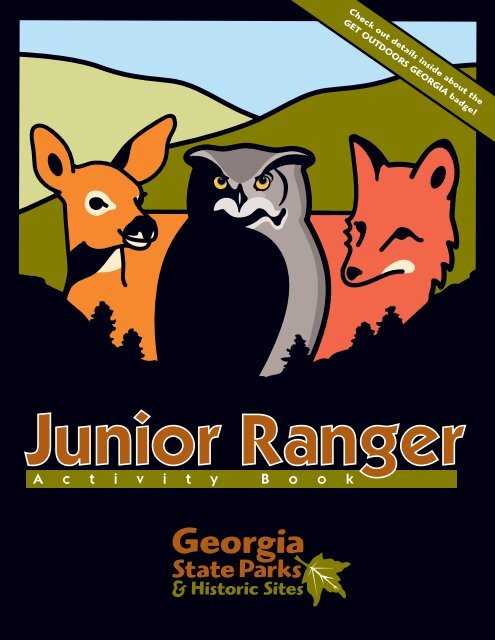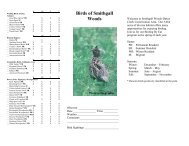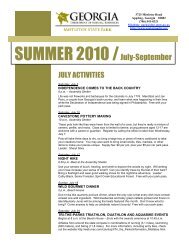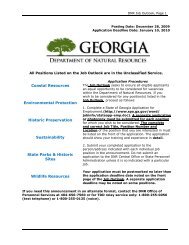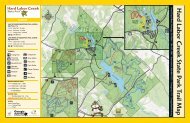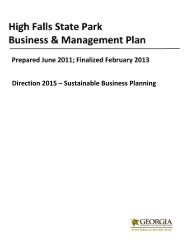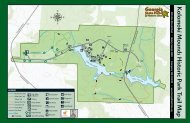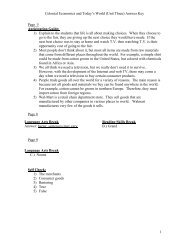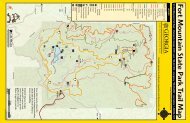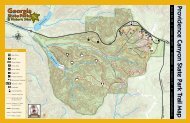Junior Ranger - Georgia State Parks
Junior Ranger - Georgia State Parks
Junior Ranger - Georgia State Parks
You also want an ePaper? Increase the reach of your titles
YUMPU automatically turns print PDFs into web optimized ePapers that Google loves.
Check out details inside about theGET OUTDOORS GEORGIA badge!<strong>Junior</strong><strong>Ranger</strong>A c t i v i t y B o o k
Dear Parents:Welcome! We are pleased that you and your family are participating in the <strong>Junior</strong> <strong>Ranger</strong>program. It is a wonderful opportunity for you to share time together in the outdoors and learn moreabout <strong>Georgia</strong>’s wealth of natural, cultural and recreational resources. Please keep in mind that itis not necessary to be trained in the natural sciences to assist your child in their efforts to become a<strong>Junior</strong> <strong>Ranger</strong>. No individual, regardless of their expertise, can answer all of the questions generatedby a curious child. Your willingness to provide encouragement and help your child find his/her ownanswers is what matters most of all.Many of the activities required for the <strong>Junior</strong> <strong>Ranger</strong> program may be completed at sites otherthan <strong>Georgia</strong>’s <strong>State</strong> <strong>Parks</strong> & Historic Sites—from other public lands to your own backyard. Publiclands include national parks, national historic sites, wildlife management areas, national wildliferefuges, local parks and historic homes. Keep in mind that our historic sites may also have uniquenatural resources and each park has its’ own history. Some <strong>Parks</strong> and Historic Sites offer <strong>Junior</strong> <strong>Ranger</strong>Day Camps in the summer months. A complete listing of camp offerings can be found on our website.The <strong>Georgia</strong> <strong>State</strong> Park system is one of the finest in the country. It is rich in many ways—fromits natural and cultural resources to the talented and devoted people who work there. The staff at<strong>Georgia</strong>’s <strong>State</strong> <strong>Parks</strong> & Historic Sites are committed to protecting our parks and sharing them withyou and your family.We would love to hear any comments you wish to share with us regarding your experience withthe <strong>Junior</strong> <strong>Ranger</strong> Program. Have fun!Sincerely,The Staff at <strong>Georgia</strong>’s <strong>State</strong> <strong>Parks</strong> and Historic Siteswww.gastateparks.org© 2008 <strong>Georgia</strong> <strong>State</strong> <strong>Parks</strong> and Historic Sites, 2 Martin Luther King Jr. Drive, Suite 1352, Atlanta, <strong>Georgia</strong> 30334.Cindy Reittinger, <strong>State</strong> Naturalist for <strong>Georgia</strong> <strong>State</strong> <strong>Parks</strong>.Designed by Lenz Design, Decatur, <strong>Georgia</strong>.
Welcome to the <strong>Junior</strong> <strong>Ranger</strong> Program<strong>Georgia</strong> is rich in natural, cultural and recreational resources. As a <strong>Junior</strong> <strong>Ranger</strong> you willexperience nature first-hand, explore <strong>Georgia</strong>’s fascinating history and have fun enjoyingrecreational activities in the outdoors.How to Become a <strong>Junior</strong> <strong>Ranger</strong>Using this activity book as your guide, complete the checklist below. When you complete eachactivity a parent or guardian must initial the item. There is no deadline for completing the program.The same book can be used as <strong>Junior</strong> <strong>Ranger</strong>s progress from level to level.When you have completed all of the requirements, you may present this page at any <strong>Georgia</strong> <strong>State</strong>Park or Historic Site office to receive your badge OR send this page or a photocopy of this page to:<strong>State</strong> Naturalist, <strong>Georgia</strong> <strong>State</strong> <strong>Parks</strong> & Historic Sites, 2 Martin Luther King Jr. Drive, Suite1352, Atlanta, GA 30334. You will receive your badge in 2-4 weeks.PLEASE PRINT CLEARLYName __________________________________ Age________ Home <strong>State</strong> ________________________Provide your e-mail address below to receive the free <strong>Junior</strong> <strong>Ranger</strong> E-NewsletterE-mail Address: ________________________________________________________________________Level I Approved____________________________________________ Date _______________________<strong>Georgia</strong> <strong>State</strong> Park or Historic Site Representative/Name of SiteLevel II Approved ___________________________________________ Date _______________________<strong>Georgia</strong> <strong>State</strong> Park or Historic Site Representative/Name of SiteLevel III Approved __________________________________________ Date _______________________Check the LevelYou Want to Achieve(Only one badge may be earned at a time.)Level II:(Recommended for ages 8-10)Must complete at least 10 activities<strong>Georgia</strong> <strong>State</strong> Park or Historic Site Representative/Name of SiteLevel I:(Recommended for ages 6-7)Must complete at least 7 activities<strong>Junior</strong> <strong>Ranger</strong> ChecklistLevel I Level II Level IIIActivity Page Parent’s InitialsBe Aware 2–3 ______ ______ ______<strong>Georgia</strong> Pines 4 ______ ______ ______Water 5 ______ ______ ______Gone Fishing 6 ______ ______ ______Outdoor Fun 7 ______ ______ ______Wildlife 8 ______ ______ ______Fruits & Flowers 9 ______ ______ ______Long Ago 10 ______ ______ ______Whooo 11 ______ ______ ______Look Up 12 ______ ______ ______Circle of Life 13 ______ ______ ______Forts 14 ______ ______ ______Bird Watching 15 ______ ______ ______Early <strong>Georgia</strong>ns 16 ______ ______ ______Lifestyles 17 ______ ______ ______Level III:(Recommended for ages 11-12)Must complete at least 14 activitiesThe following are for Level II & III onlyRare Treasures 18 ______ ______Get Involved 19 ______ ______Dear Friend 20 ______ ______Natural Features 21 ______ ______Good Fire 22-23 ______ ______Who’s Who 24 ______ ______GEORGIA STATE PARKS AND HISTORIC SITES • JUNIOR RANGER PROGRAM 1
Be Aware of Potential Dangers<strong>Junior</strong> <strong>Ranger</strong>s need to be aware of potential dangers and use good common sense when exploringin the outdoors. To meet this <strong>Junior</strong> <strong>Ranger</strong> requirement you must ask an adult to read thefollowing aloud while you listen carefully.Poison IvyPoison ivy is commonly found in <strong>Georgia</strong>’s <strong>State</strong> <strong>Parks</strong>. It may befound growing on the ground or as a hairy vine climbing up a treetrunk. Each leaf is divided into three leaflets which may be smoothor notched. Many people develop a rash when they come in contactwith this plant. Although it is not popular with people, poison ivyberries are an important food for wildlife. Find and identify poisonivy, but do not touch it.TicksA small percentage of deer ticks carry the bacteria that causes Lymedisease. Wood ticks may carry the bacteria that causes Rocky MountainPoison Ivyspotted fever. Although it wasfirst identified in the RockyMountains, most cases occurin the southeastern United<strong>State</strong>s. Be sure to check forand remove any ticks after spending time in the outdoors.Deer TickWood TickSnakesIt is very unlikely that you will encounter a snake in thewild. If, however, you should come across a snake give it>plenty of space. A snake’s most common form of defense isavoidance, so you need to give them room to flee. Look whereyou are stepping, and never reach under rocks or into openings.Six species of venomous snake occur in <strong>Georgia</strong>: eastern coral snake, timber rattlesnake (and subspeciescanebrake rattlesnake), eastern diamondback rattlesnake, pygmy rattlesnake, cottonmouth(water moccasin) and copperhead.RattlesnakeCopperhead2GEORGIA STATE PARKS AND HISTORIC SITES • JUNIOR RANGER PROGRAM
Be PreparedWear appropriate dress and comfortable walking shoes in theoutdoors. It is wise to dress in layers so that you may remove oradd layers as needed. Pay attention to local weather reports andhave rain gear available if needed. Know your abilities and physicallimits. Before setting out on a hike be aware of distances andtrail conditions. Carry water with you when walking for extendedperiods of time. Hike with a buddy and always let someoneknow where you are going.Exhaustion and exposure to cold temperatures, aggravated bywind and getting wet can cause hypothermia, the number onekiller of outdoor recreationists. Heat stroke on the other hand,can be caused by excessive heat and a lack of fluids.CollectingCollecting plants and animals or their parts is illegal in a statepark unless you have been issued a Scientific Research &Collection Permit. We have made an exception on the <strong>Georgia</strong>Pines activity page.Do Not Eat Berries orOther Wild-CollectedFoodsIt is dangerous to eat wild-collectedfoods as they may be poisonous.Lost Prevention ProgramsSome <strong>Georgia</strong> <strong>State</strong> <strong>Parks</strong> offer programs on how to avoid gettinglost in the wilderness. Check with the parks you visit to see if they offersuch a program, or if they can refer you to a park that does.When you are hiking you should always stay on the trails and staywith your group.PoisonousMushroomMuseum Manners at Historic SitesOur Historic Site museums display a variety of artifacts. Artifacts are objects remaining from aparticular time period. The artifacts you see on display in our museums and historic buildings rangefrom clothing and books to weapons and furniture. Most of these items are centuries old and veryfragile. Help us to preserve these items by following these simple rules:● Please do not touch the exhibits. Your hands leave dirt and oils on the artifacts.● Avoid using flash photography. It fades the artifacts.GEORGIA STATE PARKS AND HISTORIC SITES • JUNIOR RANGER PROGRAM 3
<strong>Georgia</strong> PinesPine trees are common in <strong>Georgia</strong>. Pine trees have specialized leaves called needles. Most pinescan be identified by measuring the length of the pine’s needles andcounting the number of needles bundled together. There are ten<strong>Junior</strong> <strong>Ranger</strong>kinds of pine trees found in our state.Collection PermitIdentify Pine TreesLEVEL I: Find and identify at least one kind of pine tree.LEVEL II: Find and identify at least two kinds of pine trees.LEVEL III: Find and identify at least three kinds of pine trees.Tape the pine needles next to the name of the tree. To measure thelength of the needles refer to the ruler on the back cover.You are hereby permitted as a<strong>Junior</strong> <strong>Ranger</strong> to collect up tothree pine needles in a state park.Name of Pine TreeTape Needle AboveName of Pine TreeTape Needle AboveName of Pine TreeTape Needle AboveCommon <strong>Georgia</strong> Pine TreesNumber of LengthSpecies Needles in Bundle of Needles HabitatVirginia 2 1.5"–3" mountains & upper PiedmontShortleaf 2 & 3 3"–5" throughout <strong>Georgia</strong>Pitch 3 3"–5" mountains of northeast <strong>Georgia</strong>Eastern White 5 3"–5" mountains of north <strong>Georgia</strong>Loblolly 3 6"–9" throughout <strong>Georgia</strong> except high mountainsSlash 2 & 3 8"–12" lower coastal plainLongleaf 3 12" coastal plainLoblolly PineShortleaf Pine4GEORGIA STATE PARKS AND HISTORIC SITES • JUNIOR RANGER PROGRAM
WaterWater is important to all living things. It comes down from the clouds as precipitation (rainand snow) and collects in many places. When raindrops hit the ground, they may percolatedown through the soil or travel over the land. They may also be taken up through plant rootsin the soil. An area of land that collects runoff from precipitation is referred to as a watershed.Run off from a watershed eventually ends up in bodies of water. In <strong>Georgia</strong> we have access to manybodies of water. Some occur naturally and some are created by man. By blocking the flow of waterusing a dam we may create a collected body of water such as a pond or lake.Observe and Study Bodies of WaterLEVEL I: Complete one of the following observation activities.LEVEL II: Complete one observation activity and one water study activity.LEVEL III: Complete observation activities at two different bodies of water and two waterstudy activities.Observation Activities______Identify plant and animal life in a body of water: lake/pond, marsh/swamp, or river/streamBody of Water and Name of Site Plant/Animal Living in Water Animal Traveling on Water Plant/Animal at Water’s EdgeObservation 2Observation 1Water Study Activities______Observe wave action at the beach. Walk along the shore and identify at least three thingsthat wash in with the waves.1.________________________ 2. ______________________ 3. __________________________Visit a stream or river. Look upstream (the direction the water comes from) and downstream. List one living thing you see in the water:________________________. List onenonliving thing you see in the water:________________________.______Visit a dam. Where does the water come from? _______________________________________Where does the water go? __________________________________________________________What is the name of the body of water created by the dam?__________________________GEORGIA STATE PARKS AND HISTORIC SITES • JUNIOR RANGER PROGRAM 5
Gone FishingHere are some tips for catching fish: 1. Fishing is good early in the morning and early inthe evening. 2. If fish aren’t biting move to a new spot. 3. Fish like cover, so fish in likelyprotected places.Go On a Fishing TripLEVEL I: Go fishing. Have your picture taken and paste the photo onthis page.LEVEL II: Go fishing and catch a fish. You must bait your own hookand cast accurately. Take a picture of the fish you caught and pasteit on this page. Identify the fish and record its weight and length under thephoto.LEVEL III: Go fishing and catch a fish. You must bait your own hookand cast accurately. Visit a fish hatchery—a site where fish areraised in pools for later release into lakes and streams. Have your picturetaken at the fish hatchery and paste it on this page. Identify where the fishhatchery is located and what kind(s) of fish are raised there under thephoto. To locate the nearest fish hatchery refer to the inside back cover.BassSunfishCatfishStaple/Paste Photo(s) Here6 GEORGIA STATE PARKS AND HISTORIC SITES • JUNIOR RANGER PROGRAM
Outdoor FunThe following is a listing of recreational activities available in <strong>Georgia</strong>’s <strong>State</strong> <strong>Parks</strong> and HistoricSites. Match the activity to the appropriate icon and circle the activities in which you haveparticipated. For each circled item write where you participated in the activity.Have Fun in the OutdoorsLEVEL I: Must match all activities with icons and participate in at least two activities.LEVEL II: Must match all activities with icons and participate in at least four activities.LEVEL III: Must match all activities with icons and participate in at least six activities.Icon Activity Where You ParticipatedFishingGuided Tour/WalkTennisSwimmingPicnickingHikingBird-watchingHorseback ridingBoatingGolfBackpackingBikingCamping______________________________________________________________________________________________________________________________________________________________________________________________________________________________________________________________________________________________________________________________________________________________________________________________________________________________________________________________________________________________________________GEORGIA STATE PARKS AND HISTORIC SITES • JUNIOR RANGER PROGRAM7
WildlifeMore than 900 different kinds of amphibians, reptiles, fish, birds andmammals live in <strong>Georgia</strong>. They range from salamanders andsnakes to wood storks and bears.If you want to observe wild animals, you must be patient. Many wildcreatures are wary of people, so you will need to move slowly and quietly.Listen carefully for sounds of movement, calls or other animal sounds.The best time to see wild animals is usually early morning and early Look for this sign…evening. Binoculars are helpful. Remember, do not feed wildlife or approach it indicates a good sitetoo closely.for viewing wildlife.Even if you do not see animals you may see signs of wildlife, includingtracks (footprints), scat (droppings), evidence of feeding, feathers, nests, and burrows.Observe WildlifeLEVEL I: Must make at least three observations of wild animals or evidence of wildlife.LEVEL II: Must make at least five observations of wild animals or evidence of wildlife.LEVEL III: Must make at least seven observations of wild animals or evidence of wildlife.You may want to visit one of more than 80 wildlife management areas around the state. (See Wildlifelisting inside back cover.)List Your Observations Below:1. ____________________________________________________________________________2. ____________________________________________________________________________3. ____________________________________________________________________________4. ____________________________________________________________________________5. ____________________________________________________________________________6. ____________________________________________________________________________7. ____________________________________________________________________________8 GEORGIA STATE PARKS AND HISTORIC SITES • JUNIOR RANGER PROGRAM
Fruits & FlowersMore than 3,500 different kinds of plants grow in <strong>Georgia</strong>. Unlike animals, plants are easy toobserve since they cannot run away! They do, however, change from season to season, so plantwatching offers different opportunities at different times of the year. Spring is usually thebest time to look for wildflowers, although there are some that bloom in summer and fall. Fall is usuallythe best time to see fruits and their seeds.Not all plants produce flowers. Non-flowering plants include ferns and mosses. Flowering plantsinclude trees, shrubs, grasses and wildflowers.Go On a Plant Scavenger HuntLEVEL I: Must find three of the plants, fruits, or flowers described below.LEVEL II: Must find five plants, fruits, or flowers as described below.LEVEL III: Must find seven plants, fruits, or flowers as described below.Remember collecting in <strong>State</strong> <strong>Parks</strong> is not allowed—see page 2.Put an X Next to the Plant, Fruit, or Flowers You Find:_____A nut or acorn (fruits from trees)_____A red flower or fruit—(red attracts hummingbirds)_____A flower with at least 5 petals_____A fuzzy seed that can be carriedon the wind_____A fern_____A grass (their flowers are tiny)_____Spanish moss hanging on a tree (it is aflowering plant and not really a moss)_____A berry—look inside for seeds (Don’ttaste or put your fingers in your mouth)_____A vine_____A flower that attracts bees or butterfliesFernSeed PodAcorn_____A fruit with tiny hooks—like burdock.These fruits stick to animals, helpingto spread their seeds._____Seeds inside a pine coneBerriesMagnoliaGEORGIA STATE PARKS AND HISTORIC SITES • JUNIOR RANGER PROGRAM9
Long Ago<strong>Georgia</strong> has a rich and fascinating history—from ancient Indian Mounds and Revolutionary Warforts to Native American settlements and Civil War battle sites. See history come to life byvisiting a Historic Site or by investigating the history of a <strong>Georgia</strong> <strong>State</strong> Park site.Investigate HistoryLEVEL I: Complete two activities.LEVEL II: Complete four activities.LEVEL III: Complete six activities.Check Completed Activities and Attach a Brochure,Map or Other Evidence that You Have Visited the Site.Historic markers can be found along roadsides allover <strong>Georgia</strong>. They mark the site of an importantevent in <strong>Georgia</strong>’s history._____Visit an historic marker. Write the title of the marker:_______________________________Visit the first state park in <strong>Georgia</strong> and drink from the spring—Indian Springs_____Visit Indian Mounds: Etowah Mounds, Kolomoki Mounds or other_____Tour an historic mill: Hamburg <strong>State</strong> Park, George L. Smith <strong>State</strong> Park, SweetwaterCreek <strong>State</strong> Park, High Falls <strong>State</strong> Park or other_____Visit a Civil War Site: Pickett’s Mill Battlefield, Fort McAllister, A. H. Stephens,Magnolia Springs, Jefferson Davis Memorial or other_____Visit an 18th Century Fort: Fort Yargo, Fort Morris, Fort King George_____Visit an historic home: Chief Vann House, Lapham-Patterson House, Little WhiteHouse, Robert Toombs House, or other._____Visit a Plantation: Jarrell Plantation, Hofwyl-Broadfield Plantation, or Traveler’s Rest_____Visit the site of this country’s first gold rush: Dahlonega Gold Museum_____Attend or participate in a living history program (people dressed in period costume)._____Many of the oldest structures on our <strong>State</strong> <strong>Parks</strong> were built by the CivilianConservation Corp (CCC) in the 1930’s. Visit the CCC Museum at Vogel <strong>State</strong>Park or look for prominent CCC structures at other parks like FD Roosevelt, HardLabor Creek, A.H. Stephens, Indian Springs, and Little Ocmulgee. What was theCCC?10 GEORGIA STATE PARKS AND HISTORIC SITES • JUNIOR RANGER PROGRAM
Whooo…!Venturing out into the natural world at night is a new experience for many people. In a safe outdoorenvironment, exploring nighttime wonders can be fun and exciting. To complete this <strong>Junior</strong><strong>Ranger</strong> requirement you must attend a <strong>Ranger</strong>-led Night Hike OR take a 30 min. walk outsideat night with an adult. You will need to get away from lights and noise to best enjoy your night hike.Since you cannot see at night, you need to use your ears and your senses of touch and smell. Listenfor owls, insects and other creatures rustling around on the ground. Does the air smell different atnight? (Wetting your nose will increase your smelling ability!) Can you distinguish between two treesby the feel of their bark?Experience the Natural World at NightLEVEL I: Take a night hike and see, hear or smell at least two night creatures.LEVEL II: Take a night hike and see, hear or smell at least three night creatures.LEVEL III: Take a night hike and see, hear or smell at least four night creatures.Circle the Creatures that you Heard, Saw, or Smelled on Your Night Hike.BatFlying SquirrelWhite-tailed DeerCricketFireflyWolf SpiderKatydid—sounds like roughsandpaper rubbing togetherRaccoonOwlFrog or ToadSkunkOpossumGEORGIA STATE PARKS AND HISTORIC SITES • JUNIOR RANGER PROGRAM 11
Look UpDay or night there is something of interest in the sky above you. You can gaze at the moon andwatch vultures circle, hawks soar, clouds float by, stars twinkle and bats flutter.View Nature Above YouLEVEL I: Find one item on the daytime checklist and one item on the nighttime checklistLEVEL II: Find two items on the daytime checklist and two items on the nighttime checklist.LEVEL III: Find three items on each checklist.Nighttime______Observe the moon. What phase is the moon:____________ Why does the moon change shape?It doesn’t. When we look at the moon we see thefront of the moon—part is lit by sunlight and partis in shade.______Observe a blue moon, shooting star or meteorshower. A blue moon is a second full moonoccurring within one month. It is a rareoccurrence______Find the Big Dipper, the Little Dipper and theNorth Star. The North Star is at the tip of thehandle of the Little Dipper.______At dusk look for bats fluttering in the sky.Phases of the MoonNew Waxing Full WaningCommonConstellationsCassiopiathe QueenDaytime______Lie down on your back and look at the cloudsfor at least 15 minutes. Think about this whileyou are cloud-watching—clouds are there becauseof the large and mighty oceans—whatdoes that mean?______Watch a hawk soaring in the sky. Hawks generallyhold their wings flat as they soar.______Watch vultures circling in the sky. Some vultureshold their wings in a V shape and teeter backand forthDracothe DragonBig Dipper______Find the moon in the daytime sky. Some days during each month you can see the moon inthe daytime sky.LittleDipperPolaris(North Star)12GEORGIA STATE PARKS AND HISTORIC SITES • JUNIOR RANGER PROGRAM
Get Outdoors <strong>Georgia</strong>It’s a perfect time to start getting healthy and fi t. Why? Because it’s good fun and good foryou. Turn off the TV, step away from the computer, put down the iPod and spend some timein nature. You’ll feel better - physically and mentally.Get Outdoors (GO) <strong>Georgia</strong> focuses on family-friendly, nature-based, healthy outdoorrecreation throughout the state. So, it’s time to “Get Out, Get Dirty and Get Fit” in the safetyand scenery of <strong>Georgia</strong>’s exceptional state parks. Our fun, fi tness-loving gopher characterchallenges you to “go for” a walk, a hike or a day in the park and to participate in plannedpromotional and recreational events and activities.
Get Outdoors <strong>Georgia</strong> BadgeWhat could be a better way to get off the couch and enjoy the greatoutdoors than with a fun-fi lled program and a Gopher badge as theincentive? The program is targeted toward ages 7 to 14, althoughyounger ages have successfully participated, too.Choose from a list of 16 different badge requirements. If youare age 7 to 10, complete 5 activities while the older kidsfrom age 11 to 14 must complete 8.Fun ideas such as setting up a campsite, paying closeattention to a sunrise or sunset, taking outdoorphotography, or participating in the Canyon Climbersor Muddy Spokes Clubs are among the list of badgerequirements.Have fun learning in the outdoors as you work towardearning a Get Outdoors (GO) <strong>Georgia</strong> badge with a funGopher mascot pictured on it. By following the guidelines andactivities listed here, you will experience nature fi rst-hand, explore<strong>Georgia</strong>’s fascinating history and enjoy outdoor recreational activities.There are 63 sites statewide and a site within about 50 miles of almost every <strong>Georgia</strong> resident.So “Get Out. Get Dirty. Get Fit.” and go for a “Gopher badge.”To earn your Get Outdoors Badge you must completethe required number of activities stated below:• Age 7-10 Must complete at least 5 activities• Age 11-14 Must complete at least 8 activitiesTo receive your free badge you can present this checklist to any <strong>Georgia</strong> <strong>State</strong> Park or Historic SiteOR mail it to: Chief Naturalist, <strong>Georgia</strong> <strong>State</strong> <strong>Parks</strong> and Historic Sites, 2 Martin Luther King Jr. Drive,Suite 1352 East, Atlanta, <strong>Georgia</strong> 30334.Please Print Clearly:Child’s Name: ________________________________________________________________ Age: ___________________________________________________________________________________________________________________Signature of parent or other adult to verify that the required activities have been completedParent or Guardian’s email address: __________________________________________________________________
Activity Checklist:❑❑❑❑❑❑❑❑Hike Near HomeFind a trail within 15 miles of your neighborhood and take a walk/hike there with your family or friends.Many urban areas have local parks and recreational trails. Other areas to consider include state parks andstate historic sites, wildlife management areas, nature centers, national forests, national parks, nationalrecreation areas, national wildlife refuges, and public fi shing areas.Make a Snack to Enjoy on HikesIt is important to take a high energy snack and water with you on a hike. Make a batch of trail mix for yourfamily to enjoy on an outing and pack it in a zip-lock bag. This high energy food (sometimes called GORP -Good Old Raisins and Peanuts) is easy to make and can be eaten on the go. Your trail mix should include1 part raisins or other dried fruit, 1 part salted nuts (peanuts, almonds or other favorites) and 1 partM&Ms.Learn a New Outdoors SkillTake lessons in swimming, tennis, horseback riding, canoeing, kayaking, sailing or golf. Lessons can betaken in formal classes (city/county recreation departments usually have quarterly publications of theiroutdoor classes) or from an experienced friend or family member. Go to a public park or natural area anduse the new skills you have learned.Enjoy a Sunrise or SunsetEnjoy the exciting events that happen as the sun is rising or setting. To plan your activity, look in thenewspaper to fi nd out what time the sun sets and rises each day. Find an open fi eld or area away frombright lights. Take a blanket to sit on and a fl ashlight. Things to watch and listen for are: bird song eitherincreasing or getting quiet, sky color changes, shadows shifting, colors beginning to appear or fade,temperature getting cooler or warmer, stars appearing or fading, fl uttering bats, wind speed or winddirection changes, artifi cial lights appear or fade. Remember to look to the east and the west to observechanges.Walk Instead of RidingWalk to an activity in your neighborhood instead of riding a bus or having someone drive you there. Thismay include walking to school, walking to the store or walking to a friend’s house. Talk to a parent orguardian before selecting this activity to be sure that there are no safety concerns.Outdoor PhotographyGo outdoors and photograph places in nature that are interesting to you. Email or mail a copy of yourfavorite photograph to <strong>Georgia</strong> <strong>State</strong> <strong>Parks</strong> and tell us why this place appeals to you (pictures may be sentto Cindy.Reittinger@dnr.state.ga.us or the address listed at the top of the checklist). Include your nameand age, the name of the site photographed and the location (city or town in <strong>Georgia</strong>). Your photo maybe displayed on our <strong>Junior</strong> <strong>Ranger</strong> website!Set-up a CampsiteLearn how to put up a tent and make a checklist of items to bring on a camping trip. Camp out in a tentfor at least one night – it can even be in your backyard!Go on a Club OutingGo on a fi eld trip with a recreation or nature club. Club members are always eager to welcome newattendees. Select a club that offers activities that you enjoy. Possibilities include: The Appalachian TrailClub (www.georgia-atclub.org), Pine Mountain Trail Association (www.pinemountaintrail.org), The <strong>Georgia</strong>Botanical Society - for plant lovers (www.gabotsoc.org), The Audubon Society - for bird lovers(www.audubon.org), and The <strong>Georgia</strong> Canoeing Association (www.georgiacanoe.org).
❑❑❑❑❑❑❑❑Document Your Outdoor Adventures with Writing and SketchesMuch about the natural history of <strong>Georgia</strong> is known today because naturalists and explorers wrote aboutwhat they saw in journals. Take a hike and write about what you saw. You can also use sketches toillustrate your journal. To see how others have done it visit your local library and look at journals writtenby two famous naturalists who wrote about their hikes in <strong>Georgia</strong>: William Bartram and John Muir. To learnmore about sketching in the outdoors look for books written by Claire Walker Leslie.Hike on the ATTake a hike on the Appalachian Trail with your family or friends. This famous trail, sometimes call “The AT”,stretches from Springer Mountain in north <strong>Georgia</strong> all the way to Maine. There are several access pointsin north <strong>Georgia</strong>. Since 1936 more than 9,000 hikers have completed the entire 2160-mile trail. For moreinformation go to www.appalachiantrail.com or www.georgiaatclub.com.Participate in a Rivers Alive CleanupRivers Alive is <strong>Georgia</strong>’s annual volunteer river clean-up that targets all waterways in the state includingstreams, rivers, lakes, beaches and wetlands. It happens every year in October and is sponsored by the<strong>Georgia</strong> Department of Natural Resources’ Environmental Protection Division and the <strong>Georgia</strong> Departmentof Community Affairs. For details go to www.riversalive.com.Attend a Public Fishing EventParticipate in a fi shing derby or other public fi shing event at any state park or public fi shing area. To fi nd anevent at a <strong>Georgia</strong> <strong>State</strong> Park check the event calendar at www.georgiastateparks.org. To fi nd an event ata <strong>Georgia</strong> Dept. of Natural Resources Public Fishing Area go to www.georgiawildlife.com.Attend a <strong>Junior</strong> <strong>Ranger</strong> CampAttend a <strong>Junior</strong> <strong>Ranger</strong> Day Camp at a <strong>Georgia</strong> <strong>State</strong> Park or Historic Site. Many parks and historic sitesoffer day camps in the summer months. For a listing of camp offerings go to www.georgiastateparks.org –the <strong>Junior</strong> <strong>Ranger</strong> webpage is listed under “Kids and Educators”Enter a Golf TournamentParticipate in a <strong>Junior</strong> Golf tournament in your community or at any of<strong>Georgia</strong> <strong>State</strong> <strong>Parks</strong>’ eight golf courses. Our <strong>State</strong> Park tournaments are forgirls and boys age 6-18. For more information go to www.georgiagolf.com.Climb a CanyonJoin the <strong>Georgia</strong> <strong>State</strong> <strong>Parks</strong>’ Canyon Climber’s Club. Hike the “canyons”at Amicalola Falls <strong>State</strong> Park & Lodge, Cloudland Canyon <strong>State</strong> Park,Providence Canyon <strong>State</strong> Park and Tallulah Gorge <strong>State</strong> Park andearn a free tshirt. Tell state park staff you are working on yourGet Outdoors Badge and the fee to join will be waived. Formore information go to www.georgiastateparks.org.Check Out our Bike TrailsJoin the <strong>Georgia</strong> <strong>State</strong> <strong>Parks</strong>’ Muddy Spokes Club. Visit 3of the 11 state parks in the Muddy Spokes Club, ridethe designated bicycle trail at each and earn a freet-shirt. Tell state park staff you are working on your GetOutdoors Badge and the fee to join will be waived. Formore information go to www.georgiastateparks.org.
Circle of LifeAs you have probably heard many times, everything in nature is connected. It is, however, suchan important message that it bears repeating. Life begins and ends, animals eat plants and biganimals eat small animals. Insects, bacteria and fungi (like mushrooms) break down dead thingsand recycle them back into the soil. This enriches the soil and helps plants grow. Mother Nature isa great recycler. Nothing is wasted.As a <strong>Junior</strong> <strong>Ranger</strong> you can help the earth by recycling at home. You should recycle newspaper,aluminum cans, glass containers and anything else that your community recycles. You can also recyclekitchen scraps like fruit and vegetable peelings by building a compost pile.Draw Nature’s RecyclersLEVEL I: Find and draw one of the following. Find and recycle one item.LEVEL II: Find and draw two of the following. Find and recycle two items.LEVEL III: Find and draw all of the following. Find and recycle three items or build acompost pile.Visit a <strong>State</strong> Park/Historic Site or Other Natural Area and Look for Examples ofthe Following. Use the Space Below for Drawing.An earthworm or a creature smallerthan an earthworm that lives in the soilLife on a rotting log.List the Items YouRecycled1.__________________________2.__________________________3.__________________________An animal eating a plantGEORGIA STATE PARKS AND HISTORIC SITES • JUNIOR RANGER PROGRAM 13
Forts, Wars and WeaponsEarly <strong>Georgia</strong>ns had to protect their land. It isbelieved that Indians built the stone wall at FortMountain to protect themselves from invadinggroups. Fort King George was built to protect the Englishfrom the Spanish and Fort Morris was used during theRevolutionary War. Fort McAlister was built to guard theOgeechee River and protect Savannah from Union troopsand ships during the Civil War.Weapons have been used by people since the beginningof time. They have been used for protection as well as tohunt animals for food. The earliest weapons were madeof stone. Later, metal such as iron and steel were used.The use of gunpowder in weapons such as cannons andguns changed the way wars were fought. Combat was nolonger man-to-man but could be conducted from a distance.Learn About Past Wars and Weapons UsedLEVEL I: Visit a historic site and examine the weapons found in the exhibits.List the types of weapons you saw: __________________________________________________________________________________________________________________Weapons are displayed at several <strong>State</strong> <strong>Parks</strong> & Historic Sites including: Pickett’sMill Battlefield, A.H Stephens, Fort McAlister, Fort King George, Fort Morris,<strong>Georgia</strong> Veterans Memorial, New Echota, Chief Vann House and Jefferson DavisMemorial.LEVEL II: Visit a fort: ______________________________Name of FortWhat materials were used to build the fort: __________________________________List the weapons they used: ________________________________________________LEVEL III: Visit a military reenactment of a battle: __________________________________Site of reenactmentDescribe who was fighting and the types of weapons they used to fight the battle____________________________________________________________________________________________________________________________________________________________________________________________________________________________________________________________________________________________________14GEORGIA STATE PARKS AND HISTORIC SITES • JUNIOR RANGER PROGRAM
Bird WatchingWatching birds is fun and it can be done anywhere. You can set up a bird feeder in your backyardto better view the birds in your neighborhood. Or, you can travel to different habitats toobserve different kinds of birds. It is helpful to use binoculars and a book called a field guideto identify the birds you see.About 400 different kinds of birds can be found in <strong>Georgia</strong>. Some of them live here year-round,others are here in spring and summer only and some just spend the winter. A few are seen onlywhen they pass through on migration.Observe Bird Behavior in Different HabitatsLEVEL I: Visit one of the habitats listed and observe at least four bird behaviors.LEVEL II: Visit two different habitats and observe at least six bird behaviors.LEVEL III: Visit three different habitats and observe at least six bird behaviors. Go on afield trip with other bird watchers, attend a bird festival or participate in<strong>Georgia</strong>’s Youth Birding Competition (see inside back cover for resources).Habitat Checklist (Birds to look for)___ Open Fields and Meadows (sparrows, eastern bluebird)___ Forests (woodpeckers, warblers)___ Wetlands - swamps, marshes (egrets, red-winged blackbird)___ Beaches (gulls, terns)___ Lakes and Ponds (ducks, herons)___ Backyards (carolina chickadee, cardinal, tufted titmouse)Bird Behavior Checklist___ Singing or calling___ Bathing in water or taking a dust bath___ Walking or hopping on the ground___ Preening (grooming its feathers with its beak)___ Flying with food or nest material in its mouth___ A group of birds perched together on a wire___ Wading in water___ Perched on a branch___ Flying (flapping wings)___ Soaring (no flapping)___ Swimming___ Feeding___ Climbing a tree trunk___ Sitting on a nestWood Duck___ Other: ___________________Great EgretPileated WoodpeckerGEORGIA STATE PARKS AND HISTORIC SITES • JUNIOR RANGER PROGRAM 15
Early <strong>Georgia</strong>nsPeople from many different places have migrated to the land we now recognize as the <strong>State</strong> of<strong>Georgia</strong>. Four of the earliest migrations are described below.People continue to migrate to <strong>Georgia</strong>. When did your family first settle in <strong>Georgia</strong> andwhere did they come from? _____________________________Learn About Four Waves of Migration to <strong>Georgia</strong>LEVEL I: Complete one activity below.LEVEL II: Complete two activities below.LEVEL III: Complete three activities below.____ Indians: The first people to arrive in <strong>Georgia</strong> were Indians. They began to settle here over10,000 years ago. Imagine what it was like to travel to a place no one had seen before! Many ofour <strong>State</strong> <strong>Parks</strong> have names derived from Indian words. Visit a site with an Indian name andfind out what the word means: ________________________________.Name of Site – meaning____ Spanish: The second wave of immigration came from Spain. Hernando de Soto was the firstEuropean to explore <strong>Georgia</strong> in 1540. The Spanish established Catholic missions throughoutsouthern <strong>Georgia</strong> including one near the modern day site of Fort King George <strong>State</strong> HistoricSite. Visit the Spanish Mission exhibit at the Fort King George museum. What was the nameof the Mission? ____________________________________________.____ English: In 1733 James Oglethorpe and 114 colonists arrived from England and settled inthe area of present day Savannah. One of these first colonists, Noble Jones, built a house atwhat is now Wormsloe <strong>State</strong> Historic Site. Visit the ruins of the home of Noble Jones. Whatwas his home made of? ______________________________________ African Slaves: Slavery was originally banned in <strong>Georgia</strong>. The law was later overturnedand slaves began arriving in <strong>Georgia</strong> in 1751. Many worked on plantations along the coastincluding at the Hofwyl-Broadfield Plantation which is now a <strong>State</strong> Historic Site. Visit thesite and find out what crop was grown there and what tasks were performed by slaves:________________________________________________ORVisit another historic site where slaves once lived and find out what tasks they performed.<strong>State</strong> Historic sites: A.H. Stephens, Jarrell Plantation, Robert Toombs House, Chief VannHouse or other __________16GEORGIA STATE PARKS AND HISTORIC SITES • JUNIOR RANGER PROGRAM
Lifestyles of the PastAll people, regardless of where they live or when they lived, have the same basic needs: food,clothing and shelter. The types of food, clothing and shelter used by people in <strong>Georgia</strong> havechanged through time. The earliest <strong>Georgia</strong>ns hunted for meat and collected nuts and berriesfor their meals. The women who lived in the 18 th and 19 th century wore long skirts. Settlers on<strong>Georgia</strong>’s coast built houses made of tabby (a mix of limestone, sand, shells and water).Learn How People Lived in the Early DaysLEVEL I: Visit an historic site, learn about thepeople who lived there and complete thelifestyle chart.LEVEL II: Visit two historic sites and complete thelifestyle chart for each site. Learn to playa game played by children of that timeperiod.LEVEL III: Visit two historic sites and complete thelifestyle chart for each site. Make yourown toothbrush and toothpaste.Make Your Own ToothbrushToothbrushes can be made from thetwigs of sweetgum or dogwood trees.Chew or shave the bark off one end ofa twig and mash the wood so that itlooks like a paint brush. You can maketoothpaste by mixing baking soda orsalt with a small amount of mint.Lifestyle ChartName of Site(s): _________________________________________________Number of years ago people lived there: ______________Type of clothing wornKind of house/buildingmaterial usedCommon foodsKind of plants grown inthe gardenMeans of transportationWhere did they go toschool?Games/Activitiesenjoyed by childrenAdult JobsChildren’s ChoresGEORGIA STATE PARKS AND HISTORIC SITES • JUNIOR RANGER PROGRAM 17
Rare Treasures(LEVEL II AND III ONLY)Did you know that of <strong>Georgia</strong>’s 3,600 species of plants approximately 600 are considered rareand that more than 200 of our 930 animal species are rare? Many of these rare creatures areendangered species or at risk of becoming endangered. They need our protection. It is gettingharder and harder to find them in the wild. See if you can find their names in this word search.Rare and Endangered Species Word SearchLEVEL II: Find and circle the names of all of the protected species in the word search.LEVEL III: Find and circle the names of all of the protected species in the word search.Highlight the plant names in green, the birds in blue, mammals in yellow,reptiles in pink, amphibians in purpleNote: The Words in Parentheses are not Included in the Word Search.Bald EagleGopher TortoiseGray BatGreen Fly OrchidGreen Salamander(Eastern) Indigo Snake(Swallow-tailed) KiteManateePitcher Plant(Green, Purple, Red)Plum Leaf AzaleaPondberryRed-cockaded(Woodpecker)(Northern) Right WhaleSea Turtle(Green, Loggerhead,Hawksbill, Leatherback,Ridley)Spotted TurtleStinking CedarStriped NewtSwamp PinkWood StorkR A D E C G N I K N I T S G GE K A N S O G I D N I A R S GE L A H W T H G I R B E B T OE C B A L D E A G L E T P R PK R O T S D O O W N O I O I HE E T A N A M P F T B K N P EG R E E N S A L A M A N D E RT B J M E Z Y I T B T F B D TX R E D C O C K A D E D E N OJ E L T R U T A E S J U R E RP I T C H E R P L A N T R W TB K H S W A M P P I N K Y T OE I V O F B G R A Y B A T R ID S P O T T E D T U R T L E SA E L A Z A F A E L M U L P E18GEORGIA STATE PARKS AND HISTORIC SITES • JUNIOR RANGER PROGRAM
Get Involved(LEVEL II AND III ONLY)Agood way to get more involved in <strong>Georgia</strong>’s <strong>State</strong> Park system is to talk to the park staff andvolunteer to help out at a <strong>State</strong> Park. <strong>State</strong> Park Volunteer Days are scheduled at different timesfor each individual park; most but not all parks have a Volunteer Day. You will need to contacta park directly to find out more.Interview Someone and Help Out by VolunteeringLEVEL II: Interview a park visitor, park staff member or park volunteer.LEVEL III: Volunteer at a <strong>State</strong> Park or Historic Site and interview a park staff member orvolunteer. Name of Park Where you Volunteered: __________________________Fill Out the Following:Person Interviewed _________________________________Date: ________________❏ Visitor ❏ Volunteer ❏ Staff, position: _____________________________Interview Questions:What do you like most about visiting (or working in) this park?How many times have you visited or (how long have you worked with) this <strong>Georgia</strong> <strong>State</strong> Park?What does the name of this Park mean?What wildlife have you seen in this park?Your own question:________________________________________________________________GEORGIA STATE PARKS AND HISTORIC SITES • JUNIOR RANGER PROGRAM 19
The site is about __________miles from my home in ________________________________________________.<strong>Georgia</strong> is home to many different plants and animals. I’ve seen_________________________________________________________________________________________________________________________________have read about include ________________________________________________________________________Dear FriendComplete the letter below and send it to someone you know. If you do not want to tear this pageout of your book, you may send a photocopy. You may use as many words as you like to fill inblanks.Write a Letter to a FriendDear _________________________________________,Date: ___________________________I enjoyed my visit to __________________________________ located near __________________, Ga.Write a few sentences about the park or historic site and describe the things you did during your visit.There is a state park within 50 miles of every <strong>Georgia</strong> resident. The nearest parks to you are____________________________________________________(refer to the map on the back). You maywant to visit one some time!Did you know there are threatened and endangered species right here in <strong>Georgia</strong>? Some of the ones I________________________________________________________________ (Refer to Rare Treasures page 18)Yours truly,_____________________________________________20GEORGIA STATE PARKS AND HISTORIC SITES • JUNIOR RANGER PROGRAM
Natural Features of <strong>Georgia</strong>(LEVEL II AND III ONLY)Wind, water and fire over time have created the landscape we see in <strong>Georgia</strong> today. Thediversity of natural environments found here range from mountains to seashore.The southern tip of the Appalachian Mountains can be seen in northeast <strong>Georgia</strong>, in an area calledthe Blue Ridge. Because they are very old mountains they have experienced more weathering andare therefore not as tall as mountains in the western U.S. In the Piedmont, an area of rolling hillsjust south of the mountains, you can find large areas of exposed rock called granite outcrops.<strong>Georgia</strong>’s Stone Mountain is the largest granite outcrop in the world.Below the fall line (an imaginary line that stretches from Columbus to Augusta) is the CoastalPlain area. The fall line represents the coastline of long ago when what is now south <strong>Georgia</strong> wasunderwater. The soil in the Coastal Plain is sandy.Visit Unique Natural Areas and Plot Their Location on a MapLEVEL II: Visit one of the natural features described below and mark the site on the map.LEVEL III: Visit two of the natural features describedbelow and mark them on the map.Cumberland PlateauRidge & ValleyBlue Ridge____ Visit a mountain stream in the Blue Ridge area andlook for trout: Moccasin Creek <strong>State</strong> Park, SmithgallWoods, Unicoi <strong>State</strong> Park or other.____ Visit a granite outcrop in <strong>Georgia</strong>’s Piedmont andsee lichen growing on the exposed rock: PanolaMountain <strong>State</strong> Park, Stone Mountain, ArabiaMountain or other.____ Visit a longleaf pine and wiregrass community andlook for gopher tortoise. This rare natural communitycannot persist without fire: General Coffee <strong>State</strong>Park, George L. Smith <strong>State</strong> Park, Hofwyl-BroadfieldPlantation, Reed Bingham <strong>State</strong> Park, Seminole<strong>State</strong> Park.PiedmontCoastal Plain____ Visit a salt marsh on the coast and look for fiddlercrabs: Crooked River <strong>State</strong> Park, Skidaway Island <strong>State</strong> Park, Fort McAllister <strong>State</strong>Historic Site, Wormsloe <strong>State</strong> Historic Site.____ Visit Cloudland Canyon <strong>State</strong> Park located in the Cumberland Plateau region. Take a hikein the canyon, it looks unlike any other part of <strong>Georgia</strong>.____ Visit Providence Canyon, Tallulah Gorge, Amicalola Falls or the Okefenokee Swamp(Stephen C. Foster <strong>State</strong> Park) and see why each is listed as one of <strong>Georgia</strong>’s Seven NaturalWonders.GEORGIA STATE PARKS AND HISTORIC SITES • JUNIOR RANGER PROGRAM 21
Good Fire and Pushy Plants(LEVEL II AND III ONLY)The staff at <strong>Georgia</strong>’s <strong>State</strong> <strong>Parks</strong> and Historic Sites are responsible for taking care of the landand protecting the plants and animals that live there. Sometimes this requires starting firesand getting rid of pushy plants that don’t belong there.Fire is a Natural Part of the LandscapeFires can be started by lightning; these natural fires are nature’sway of taking care of the land. Scientists now know that fires areneeded to keep forests healthy. Fire helps to cycle nutrients andpromote diversity in the existing plant and animal community.While we must protect our homes and communities from badwildfires, we must also provide nature with the fire it needs. To dothis our park staff set carefully controlled fires. Setting these goodfires is called prescribed burning.Pushy Plants Upset the Balance of NatureSome of the plants that live in <strong>Georgia</strong> were brought here from otherplaces. Most of them are not a problem but, a few of them are pushyand crowd out our native plants. Scientists call these “pushyplants” non-native invasive plants.A park ranger uses a drip torchto start a fire.Some pushy plants grow so thick that they cover up other plantsand block out the sunlight they need to grow. Pushy plants alsoaffect wildlife because animals need native plants for food and shelter. You should never plant apushy plant in your yard. It may spread or the seeds may be carried to other places and start newplants.KudzuKudzu is sometimes called the vine that ate the south.Water HyacinthWater hyacinth grows in lakes and other waterways.22GEORGIA STATE PARKS AND HISTORIC SITES • JUNIOR RANGER PROGRAM
Good Fire and Pushy Plants (continued)Chinese WisteriaEnglish IvyPhotographs courtesy of University of <strong>Georgia</strong>www.invasive.orgMimosa TreeSpread the Word About Good Fire and Pushy PlantsGetting rid of pushy plants and using prescribed fire are new ways of helping nature that manypeople don’t understand. You can help by learning more about it and sharing what you learn withothers. You may need to ask a park ranger to direct you to a recently burned part of the park or toa place where pushy plants can be found.LEVEL II: Find at least one pushy plant and complete one activity from the list below.LEVEL III: Find at least two kinds of pushy plants and complete both activities.Find a Pushy Plant:___Chinese Privet___Chinese Wisteria___English Ivy___Japanese Honeysuckle___Kudzu___Mimosa Tree___Popcorn Tree (also called Tallow Tree)___Water Hyacinth___Other: _______________________Activities____ Collect leaves from a pushy plant and make a leaf rubbing by placing the leaves under apiece of paper and rubbing a crayon across the paper. Label your rubbings and make aposter to educate others about pushy plants.____ Visit a recently burned site on a park or other natural area. How can you tell the site hasbeen burned? Look for evidence of new plant growth. Make a poster to educate othersabout using fire to keep forests healthy.GEORGIA STATE PARKS AND HISTORIC SITES • JUNIOR RANGER PROGRAM 23
Who’s Who in <strong>Georgia</strong>(LEVEL II AND III ONLY)Many of our <strong>State</strong> <strong>Parks</strong> and Historic Sites are named after people. Match the name of theperson to the description of their identity. It may be helpful to refer to our Guide to <strong>Georgia</strong><strong>State</strong> <strong>Parks</strong> and Historic Sites (a free publication available at all of our sites.)Learn About the People that <strong>Parks</strong> and Historic Sites HaveBeen Named ForLEVEL II: Match all of the Names and Identities and visit at least one site.LEVEL III: Match all of the Names and Identities and visit at least two sites.NameA.H. StephensFranklin D. RooseveltChief VannElijah ClarkJefferson DavisLaura S. WalkerRobert ToombsStephen C. FosterIdentity<strong>Georgia</strong> Governor and Vice President of the ConfederacyPresident of the Confederacy captured by Union calvary32nd President of the United <strong>State</strong>s who had a home in WarmSprings, <strong>Georgia</strong><strong>Georgia</strong> Senator who said “Defend yourselves; the enemy is atyour door”Teacher, writer and naturalistFrontiersman and Revolutionary War heroComposer who wrote a famous song about the Suwannee RiverBuilt the first brick home in the Cherokee NationVisit the <strong>Parks</strong> and Historic Sites Named for these People:____ Dowdell’s Knob at FD Roosevelt <strong>State</strong> Park: see where FDR enjoyed picnics.____ Chief Vann House: look for the burn mark on the stairs where the <strong>Georgia</strong> Militia “smoked”Joseph Vann from the home.____ Jefferson Davis Memorial: see where Davis was captured.____ AH Stephens <strong>State</strong> Historic Park Museum: see the Civil War Medical exhibit.____ Take a nature hike at Laura S. Walker <strong>State</strong> Park: write a story about what you saw.____ Fargo Visitor Center at Stephen C. Foster <strong>State</strong> Park: see the Suwannee River.____ The cabin at Elijah Clark <strong>State</strong> Park: learn how people lived in the 1780s.____ The Robert Tombs house: see General Toombs’ swords.24GEORGIA STATE PARKS AND HISTORIC SITES • JUNIOR RANGER PROGRAM
Learn More About ItLearning about our natural and cultural resources is a never-ending adventure. Check out thevaluable resources below to learn more about topics covered in this activity book.Bird Watching●●●Civil WarYouth Birding Competition and Birding Trail brochures, <strong>Georgia</strong> Wildlife ResourcesDivision, 478/994-1438, www.georgiawildlife.com.Field trips with <strong>Georgia</strong> Audubon Societies, www.audubon.org/states.Birding Festivals: www.coastalgeorgiabirding.org, www.pinewoodsbirdfestival.com.The Civil War in <strong>Georgia</strong>: An Illustrated Traveler’s Guide - view it online at www.sherpaguides.com.Fishing●●Map of <strong>Georgia</strong>’s Public Fishing Areas & Fish Hatcheries – refer to <strong>Georgia</strong> Sport FishingRegulations available wherever fishing licenses are sold or call 770/918-6418.<strong>State</strong>wide calendar of Kid’s Fishing events, www.georgiawildlife.com.<strong>Georgia</strong> <strong>State</strong> <strong>Parks</strong> & Historic Sites - <strong>Junior</strong> <strong>Ranger</strong> ProgramVisit the <strong>Junior</strong> <strong>Ranger</strong> page on our website: www.gastateparks.org● Check out our statewide listing of <strong>Junior</strong> <strong>Ranger</strong> Summer Day Camps.● Subscribe to the free <strong>Junior</strong> <strong>Ranger</strong> E-Newsletter.Recycling & Compostingwww.earth911.org. Just enter your zip code to identify recycling sites in your community.TreesNative Trees of <strong>Georgia</strong> (free book), <strong>Georgia</strong> Forestry Commission, 1-800-GATREES.www.gfc.state.ga.us.Wildlife<strong>Georgia</strong> Wildlife Viewing Guide - view it online at www.sherpaguides.com.Map of <strong>Georgia</strong>’s Wildlife Management areas – request the WRD general brochure, 770/918-6404.Express Yourself in Competitions sponsored by the <strong>Georgia</strong> Department ofNatural ResourcesRiver of Words – statewide poetry and art competition, 404/675-1638, www.gaprojectwet.org.Give Wildlife a Chance Poster Contest, 478/994-1438, www.georgiawildlife.com.GEORGIA STATE PARKS AND HISTORIC SITES • JUNIOR RANGER PROGRAM
INCHES 1 2 3 4 5 6 7 8 9 10<strong>Georgia</strong> <strong>State</strong> <strong>Parks</strong> and Historic SitesCoca-Cola Bottlersof <strong>Georgia</strong> is aproud sponsor of the<strong>Junior</strong> <strong>Ranger</strong> Program


